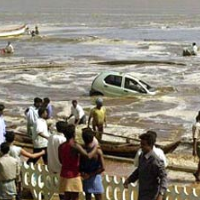India Adds Another Level to Tsunami Defences
 The 2004 tsunami killed around 10,000 people in India (file photo: AP)
The 2004 tsunami killed around 10,000 people in India (file photo: AP)
With the 10th anniversary of the 2004 tsunami disaster commemorated on Friday, India has not only an effective warning system in place to prevent a repeat of the tragedy, but it is also capable of providing advisories to the 25 countries around the Indian Ocean. The country built and operationalized its warning system in 2007, and is now adding another layer of detection that would reportedly ensure an almost certain warning of any tsunami in the region.
The Indian Tsunami Early Warning Centre (ITEWC) at the Indian National Centre for Ocean Information Services (INCOIS), Hyderabad, can provide an advance warning of two-and-a-half hours on the mainland to take precautionary measures in the case of another tsunami, including evacuating coastal villages, if necessary.
At the heart of this warning system is its ability to detect a tsunami early, using Bottom Pressure Recorders (BPRs) that India has installed in the ocean depths about 3,500 metres below the surface, close to the faultlines where earthquakes are generated.
During a tsunami the ocean surface level changes sharply, thereby changing the water pressure being measured by the BPR. A change in the surface water level of even a centimetre can be detected by the BPRs.
According to the Indian Express, this is the standard method worldwide to detect the generation of tsunamis and the system has served India’s needs well in the past seven years. But the government is now planning to go further and install GPS-based detection systems in the Andaman and Nicobar Islands to provide a second layer of data collection.
“Tsunamis are generated only by earthquakes that are a result of vertical movements of tectonic plates. Vertical movements also cause tilts on the earth’s surface along the earthquake’s faultlines. During the 2004 tsunami, for example, some places in the Andaman Islands, which lie along the faultline, got tilted by about a metre. The GPS systems will be able to record such changes on the earth’s surface, and can supplement the observations from the BPRs. This will add additional strength to our system,” said Shailesh Nayak, Secretary, Ministry of Earth Sciences.
Around 35 GPS stations would be set up by October 2015 at a cost of Rs 20 lakh ($31,400) each. Nayak believes that GPS-based systems are ideal for India’s location.
“The GPS systems can give greater accuracy in predicting the magnitude of the tsunami. The 2011 tsunami that hit Japan had been significantly underestimated initially. Though Japan has GPS-based systems, it generally gets very little time to analyse the data. We are lucky that our shores are some distance away from the faultline. The GPS system can be very useful in our case,” he told The Indian Express.
The 2004 tsunami was caused by a 9.3 magnitude earthquake in the Bay of Bengal. It killed more than 200,000 people in about 15 countries in the region, including more than 10,000 in India.
Nayak said the absence of an early warning system in India at that time was not because of any lack of capability or expertise, but because no one had thought that a tsunami of that size could ever hit India. Not much is known about the last major tsunami to hit India, in the 1880s.
Following the 2004 tsunami, the government had authorized the setting up of the tsunami warning centre, which was ready by October 2007 at a cost of $28 million.
In last seven years, it has recorded 37 undersea earthquakes and issued a warning once in 2012 for the Andaman and Nicobar islands when an undersea earthquake of 8.7 magnitude occurred. It provides information to authorities in South Asia, Southeast Asia and the Middle East about earthquakes being generated in the Indian Ocean region, and whether they were likely to produce tsunamis.
A tsunami consists of a series of ocean waves of extremely long wavelength around 100-250 km in the deep ocean, generated primarily by an earthquake occurring below the ocean floor. Underwater volcanic eruptions and landslides can also generate a tsunami.
India also supports the multilateral approach to combating natural disasters in the Asia Pacific. The government on Friday announced a $1 million contribution to a UN fund for strengthening early warning systems.
India’s Ambassador to Thailand, Harsh Vardhan Shringla, said the donation would ensure that vulnerable communities receive advance warnings that could save lives and livelihoods in disasters.
- Karan Singh
To Learn More:
10 years on, India to add new GPS security layer to upgrade Tsunami alert system (by Amitabh Sinha, Indian Express)
India announces USD one million for UN tsunami fund (PTI)
Tamil Nadu pays homage to 2004 tsunami victims (IANS)
10 years of tsunami: India learnt its lesson by developing early warning system (OneIndia)
Indian Ocean tsunami anniversary: ‘Tsunami taught administrative as well as lessons for life’ (IANS)
India approves $28m tsunami alert (BBC News)
- Top Stories
- Controversies
- Where is the Money Going?
- India and the World
- Appointments and Resignations
- Unusual News
- Latest News
- India College Chain’s Expansion into U.S. Draws Opposition from Massachusetts Officials over Quality of Education
- Milk Shortages in India Tied to Release of New Movies Featuring Nation’s Favorite Stars
- Confusion Swirls around Kashmir Newspaper Ban in Wake of Violent Street Protests
- Polio-Free for 5 Years, India Launches Vaccine Drive after Polio Strain Discovery
- New Aviation Policy Could Increase Service, Lower Ticket Prices






Comments